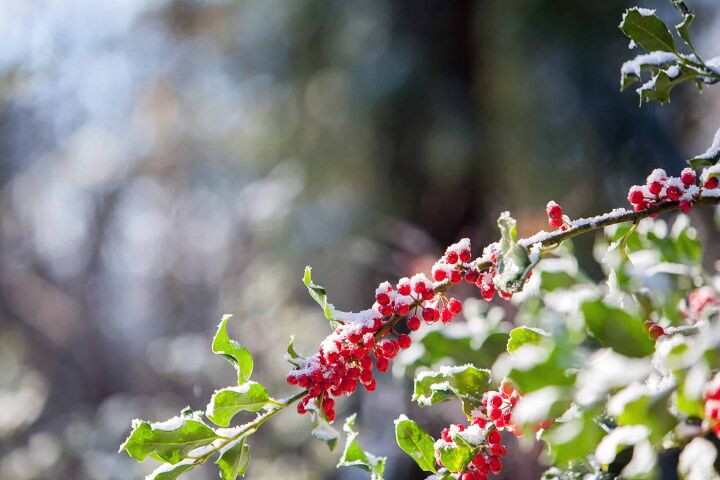20 Different Types of Holly Bushes (with Photos)

Holly bushes and trees are a great way to bring life to your garden during the winter months. While, in the summer, hollies can create a dreamy backdrop for the rest of your plants and shrubs. These plants are very popular in Christmas décor, mostly due to the fact that they are often associated with symbols of renaissance and hope.
Wild-grown holly plants are found throughout the temperate and tropical regions of the world. In autumn, berries and fruits appear in a wide array of colors including pink, yellow, white, black, and numerous shades of red. Most, though not all, holly plant varieties feature characteristic glossy green leaves with serrated edges and barbed teeth. Virtually all holly species are dioecious, meaning that if you want fruit you’ll have to plant both male and female.
The holly plant is a part of the Ilex genus, which consists of roughly 480 species of evergreen and deciduous shrubs, trees, and climbing lianas. The English holly and the American holly are the most common types of holly bushes used in holiday décor, though there are countless other options available. With so many types of hollies to choose from, there is sure to be one, or many, that will meet your landscape needs.
Do You Need Landscaping Services?
Get free, zero-commitment quotes from pro contractors near you.

18 Types of Holly Bushes
1. American Holly
The American holly (Ilex opaca) is commonly used as a substitute for the English holly in Christmas décor, in areas where the latter doesn’t grow as well. Both varieties look similar, in that they have an abundance of red berries and sharp-toothed foliage. This holly plant goes by many other names, include scrub holly, dune holly, and hummock holly. It is native to eastern and south-central United States, and also west to southeastern Missouri and in eastern Texas.
This type of holly is an evergreen tree, reaching an average height between 33 and 36 feet, but can grow to up to 60 feet tall. The American holly’s trunk diameter is typically 20 inches, though, it can reach up to 47 inches on occasion. The ‘Croonenburg’ variety of the American holly can pollinate itself, due to the fact that it has both male and female flowers on the same plant. This variety is also an excellent choice if you only have room for one holly tree. Alternatively, if you want yellow fruit, opt for the ‘Canary’ variety.
- USDA Zones: 5 to 9
- Height: 25 feet to 65 feet
- Sun Exposure: Full sun to partial shade
- Growth Rate: Moderate
- Soil Preference: Acidic, moist, loamy, sandy, rich, well-drained and clay soils
2. English Holly
The English holly (Ilex aquifolium) is typically the type of holly that you think of when it comes to Christmas. Its recognizable shape has inspired many songs and is used in various decorations related to the holiday. The English holly goes by many other names including the European holly, common holly, Christmas holly, and even the Oregon holly.
These hollies can be recognized as either small trees or large shrubs. They typically reach a height of between 10 and 40 feet. Like the American holly, the English holly has spines on the edges of their deep, shiny green leaves. All-female varieties produce fragrant white flowers in early summertime, which develop into bright berries in white, yellow, orange, or red colors. Though, red is the most common.
- USDA Zones: 6 to 8
- Height: 10 feet to 40 feet
- Sun Exposure: Full sun to partial sun
- Growth Rate: Slow to medium
- Soil Preference: Can adapt to light (sandy), loamy (medium), and heavy clay soils. Though, they prefer a moist, well-drained acidic soil of average fertility.
3. Carolina Holly
The Carolina holly (Ilex ambigua) is one of the many deciduous holly species. It tends to grow well in sandy soils, which has earned it the well-known nickname of the sand holly. This holly is native to the southeastern and south-central United States. It can be either a large shrub or small tree, which reaches up to 20 feet tall.
This type of holly features branches that are covered in either a shiny dark brown or black bark, with purple twigs. Carolina hollies produce red fruits in the fall, though they typically fall off easily which makes the plant less visually appealing when winter comes around. Other commonly understood names for the Carolina holly are the ambiguous winterberry and the possum holly.
- USDA Zones: 7 to 9
- Height: 15 feet to 20 feet
- Sun Exposure: Full sun to partial shade
- Growth Rate: Slow to medium
- Soil Preference: Prefers sandy soils
4. Catberry Holly
Formerly known as Nemopanthus mucronatus, the Catberry, or mountain holly, is now apart of the Illex genus as Ilex mucronate. It is closely related to the swamp holly, a rare species found in the southeastern United States. The Catberry is a deciduous type of holly that grows between 6 and 10 feet high. It is native to eastern parts of North America and is ideal for moist areas.
Similar to the long-stalked holly, the Catberry’s red fruit can be found at the end of long stems, or peduncles. Unlike other deciduous hollies, this species does not develop good fall color. The leaves are simple, alternate and slightly toothed on the ends. They are bluish-grey in color and the stems have a purple hue when young.
- USDA Zones: 4 to 6
- Height: 6 feet to 10 feet
- Sun Exposure: Full sun to partial shade
- Growth Rate: Slow to medium
- Soil Preference: Wet soil
5. Hawaiian Holly
The Hawaiian holly (Ilex anomala), as the name indicates, is a holly species that is native to the Hawaiian Islands, where it is often referred to as ʻAiea, kāwaʻu, kä‘awa‘u, or Hawai’i holly. In fact, it is the only indigenous member of the Holly family that is native to the Hawaiian Islands. These shrubs grow to reach an average height of 30 to 40 feet, with a lifespan of over five years.
The fruit on the Hawaiian holly is a purple-black color, while the leaves are a glossy, dark green with paler green undersides. These hollies also form clusters of white flowers with greenish centers. Hawaiian hollies can be grown as an annual in your garden, but are suitable for growing in containers. They also make great houseplants.
- USDA Zones: 11 to 12
- Height: 15 feet to 40 feet
- Sun Exposure: Full sun to partial sun
- Growth Rate: Medium
- Soil Preference: Well-drained soil, cinder, and organic soil
6. Finetooth Holly
The Finetooth holly (Ilex serrata) is another form of deciduous holly, which handles cold temperatures better than many other varieties. These hollies may also be called the Japanese winterberry or simply deciduous holly. The finetooth holly is commonly seen across Japan and China, growing between 6 and 15 feet tall on average.
This type of holly is often confused with the winterberry, though there are differences between the two species. First, finetooth hollies have smaller berries and is a semi-evergreen tree, meaning it does not shed all of its leaves during the winter. The berries produced by this holly are a gorgeous glossy and bright red, which can add exceptional beauty to a winter landscape.
- USDA Zones: 5 to 8
- Height: 6 feet to 15 feet
- Sun Exposure: Full sun to partial shade
- Growth Rate: Slow to medium
- Soil Preference: Moist to wet, rich acidic soils.
7. Japanese Holly
The Japanese holly (Ilex crenata) is commonly referred to as the box-leaved holly because the leaves look similar to those found on boxwood shrubs. These evergreen shrubs are native to easter China, Korea, Japan, Sakhalin, and Taiwan. They are usually grown for their dense evergreen foliage, which is wildly popular among bonsai enthusiasts.
Fruit produced by the Japanese holly is black and not as distinct as other species in the genus. In some areas of the world, this holly is considered to be invasive. Compared to Chinese varieties, the Japanese hollies have a soft texture. They do not thrive well in regions with hot temperatures, and don’t manage well in exceptionally cold climates either.
- USDA Zones: 5 to 8
- Height: 3 feet to 10 feet
- Sun Exposure: Full sun to partial shade
- Growth Rate: Medium
- Soil Preference: Light, well-drained, slightly acidic soil with sufficient organic material.
8. Common Winterberry
The common winterberry holly (Ilex verticillata) is a deciduous shrub that is native to the eastern United States. It can make a wonderful addition to your landscape, due to its bright red berries that last throughout winter and into spring. Not only will these hollies add gorgeous color to winter landscapes, they also attract colorful birds to feed on the berries.
Winterberries have dark green, elliptical leaves that are roughly two to three inches in length. Although the shrub doesn’t typically produce impressive fall color, the winterberry may turn a lovely maroon color some years. This holly performs well in wet areas, as its native habitats are locations like swamps and bogs.
- USDA Zones: 3 to 9
- Height: 3 feet to 15 feet
- Sun Exposure: Full sun to partial shade
- Growth Rate: Slow
- Soil Preference: Medium-moisture to wet; acidic soil.
9. Dahoon Holly
The Dahoon holly (Ilex cassine) is native to Puerto Rico, the Caribbean, and the southeastern coast of North America. They traditionally found growing in swampy areas, and will prefer an area of your garden that is wetter than others. The Dahoon holly’s leaves are evergreen, with a dark, glossy green hue and some spines at the top. These hollies are commonly grown as ornamental plants, for their bright berries that contrast the dark green leaves.
At their maximum height, dahoon hollies are large enough to create an appealing amount of shade, but not too large that they take over your entire yard or conceal the front of your home. There are three varieties of the Dahoon holly: Ilex cassine var. cassine, I. cassine var. angustifolia and I. cassine var. mexicana. Some botanists consider the myrtle-leaves holiday to be a type of this species.
- USDA Zones: 5 to 10
- Height: 20 feet to 40 feet
- Sun Exposure: Full sun to partial shade
- Growth Rate: Moderate
- Soil Preference: Moist soils; clay, loamy, or sandy conditions
10. Inkberry Holly
The Inkberry holly (Ilex glabra) is also commonly referred to as Appalachian tea, gallberry, or the evergreen winterberry. It is native to the coastal plain of eastern North American, often found in western Louisiana. Though it generally grows near swamps and bogs, it can also grow well in sandy wooden locales.
This type of holly is known to be relatively easy to grow and offers stunning color during the winter. It is slow-growing in an upward clumping style, reaching an average of 5 to 8 feet high. These hollies have dark green leaves and can range from elliptical to oval in shape. Their name comes from the fruits that the plant produces. If you don’t prune away the suckers, the Inkberry holly can be invasive.
- USDA Zones: 5 to 9
- Height: 5 feet to 8 feet
- Sun Exposure: Full sun to partial shade
- Growth Rate: Slow
- Soil Preference: Woodland soils, sandy, and acidic
11. Longstalked Holly
The longstalk holly (Illex pedunculosa) gets its name because the fruit that it produces grows at the end of a long stalk, called a peduncle. These types of hollies are an excellent choice for adding a pop of color to your garden during fall and winter months. They are also a great choice for urban areas, as they can tolerate both pollution and salt exceptionally well.
This holly is often under-used in home landscape. Though, its shimmering, wavy leaves can add motion and depth to any garden, as they catch the sun’s light. While the bright, red berries of the longstalk holly add unmatched beauty and provide food for native birds. Many botanists consider longstalk hollies to be one of the most handsome of the evergreen hollies to grow in northern gardens.
- USDA Zones: 5 to 8
- Height: 10 feet to 30 feet
- Sun Exposure: Full sun to partial shade
- Growth Rate: Slow to medium
- Soil Preference: Average, medium, well-drained soil
12. Myrtle-Leaved Holly
The myrtle-leaved holly (Illex myrtifolia) feature leaves that are similar to those found on the myrtle – hence the name. It is somewhat shrubby plant with gray bark and bright red berries. This holly is characterized by its set of red and yellow fruit that persists through the fall and winter months. Many botanists consider the myrtle-leaved holly to be a variety of the dahoon holly, and the two cross in some situations.
- USDA Zones: 7 to 10
- Height: 15 feet to 25 feet, though some can reach to be over 40 feet tall
- Sun Exposure: Full sun to partial shade
- Growth Rate: Medium
- Soil Preference: Loamy or sandy, acidic soil.
13. Lusterleaf Holly
The lusterleaf holly (Illex latifolia) is a large, dense evergreen shrub or small tree that reaches over 20 feet in height. To produce berries, this holly requires both male and female plants. It is tolerant to both shade and drought, and is characterized by its shiny leaves and heavy set of red fruit. The fruits of the lusterleaf holly grow on short peduncles in axillary clusters around twigs.
Although the berries are not as bright as other varieties, the lusterleaf holly can still add wonderful color during winter months. You may find this type of holly referred to as the Rajo holly, or simply Tarajo. The lusterleaf holly is native to China and Japan.
- USDA Zones: 7 to 9
- Height: 15 feet to 25 feet, though can reach up to 60 feet in native situations
- Sun Exposure: Full sun to partial shade
- Growth Rate: Medium
- Soil Preference: Loamy or sand with high organic matter; good drainage; acidic
14. Round Leaf Holly
The round leaf holly (Ilex rotunda), or commonly referred to as the Kurogane holly, is an evergreen tree that is native to East Asia. It is primarily found in Vietnam, Japan, Taiwan, Korea, and China, where its natural habitat is broadleaf evergreen forests in areas that get plenty of sun. The leaves found on the round leaf holly are leathery and spineless, and like most other hollies, the plant produces bright red berries.
This tree is one of the many that returned quickly after the Hiroshima bombing in 1945 – a testament to its persistence. As you might expect, it is pollution tolerant and relatively easy to transplant. The surviving round leaf hollies were given the Japanese name Hibakujumoku. It is also considered the official tree of many Japanese municipalities.
- USDA Zones: 9 to 11
- Height: Up to 40 feet tall
- Sun Exposure: Full sun to partial shade
- Growth Rate: Slow
- Soil Preference: Tolerates poor, sandy, and clay soils
15. Yaupon Holly
The Yaupon holly (Ilex vomitoria) is ideal for those who live near the ocean, as it is incredibly tolerate to salty conditions. It also performs well as a drought-tolerate tree. The holly plant is native to southeastern United States and is commonly grown as a privacy screen or hedge shrub, as it requires minimal shaping and comes in a range of appealing slow-growing varieties.
Yaupon hollies have oval green leaves, with fine-toothed margins that may be rounded or pointed. In the spring, this holly produces small greenish-white male or female flowers. Only female yaupon hollies will produce fruit, which are small berries that are usually red but can sometimes be a more yellowish color.
Like most other hollies, the yaupon holly is deciduous which means you’ll need to plan a male pollinator for it to flower and bear fruit. This holly is one of the more tolerant types of hollies, as it grows well in a variety of sun exposures, moisture levels, soil types, and pH levels. It is also one of the four caffeinated holly plants out there.
- USDA Zones: 7 to 9
- Height: 4 feet to 30 feet
- Sun Exposure: Full sun to partial shade; thrives best with plenty of sunlight
- Growth Rate: Slow to medium
- Soil Preference: Prefers sandy soil; can do well in other soil textures, though
16. Yerba Mate
Yerba mate (Ilex paraguariensis) is likely the most well-known of the four types of holly plants that are caffeinated. In fact, it has been consumed by native South Americans for longer than recorded time. The popular herbal tea that this holly plant produces is traditionally placed in a gourd and served with a metal straw. It has a full-bodied and distinctive green, grassy taste.
The foliage of yerba mate plants contains caffeine and theobromine, commonly found in cacao beans. This plant species requires acidic soil to grow successfully and is native to the subtropical forests of South America. It is considered a hardy plant and goes largely unaffected by diseases and pests.
- USDA Zones: 9 to 11
- Height: Up to 60 feet tall
- Sun Exposure: Full to partial shade
- Growth Rate: Slow
- Soil Preference: rich, loamy, well-drained, acidic soil that absorbs and retains moisture well
17. Small-Leaved Holly
Some varieties of hollies, such as the small-leaved holly (Ilex canariensis) are less widespread and can only be found in limited areas. This type of holly is native to a select few islands near the northern coast of Africa – particularly the Micronesian islands of Madeira and Canarias. The plant grows in a type of forest referred to as a laurisilva or laurel forest.
In Spanish, the holly is known as acebiño and azevinho in Portuguese. It has glossy ovate leaves, with usually rounded edges and a few spines. The flowers that the small-leaved holly produces have four to six white petals and grow in small clusters, while the fruits are globular and the characteristic red color. Currently, this species of holly is threatened by habitat loss.
- USDA Zones: 11 to 12
- Height: Up to 32 feet tall
- Sun Exposure: Full sun to partial shade
- Growth Rate: Medium
- Soil Preference: Acidic, well-drained soil
Do You Need Landscaping Services?
Get free, zero-commitment quotes from pro contractors near you.

18. Blue Princess Holly
The blue princess holly is a female cultivar, belonging to the blue holly group of broadleaf evergreen shrubs. They are commonly seen in home landscapes or as hedge shrubs. When it is pollinated by the male cultivar, ‘Blue Prince,’ is produces the distinctive bright red berries that we associate with nearly all holly plants. The leaves of the blue princess holly are a glossy, dark green color, with a bluish cast, and some spines.
Like most other holly plants, the blue princess holly is deciduous. To determine whether you have a blue princess or a blue prince, examine the flowers. Though both have small clusters of creamy white flowers, you can distinguish a blue princess by their less prominent stamens.
- USDA Zones: 5 to 8
- Height: Up to 15 feet tall
- Sun Exposure: Full sun to partial shade
- Growth Rate: Slow
- Soil Preference: Slightly acidic to neutral; sand to heavy clay
19. Possumhaw Holly
The Possumhaw Holly (Ilex decidua), unlike most other holly species, loses its leaves every winter. While this type of holly can grow to reach up to 20 feet tall, it is more commonly grown as a shorter, clumping shrub. Whether it’s grown as a small tree or shrub, possumhaws can be very ornamental. They produce a number of thin trunks, or stems and grow in thick clumps that can act as a hedge or screen.
Although the female variety of the possumhaw holly is not very showy in summer months, they are exceptional in the fall and winter. All the leaves fall in the autumn, leading the way for beautiful, clearly visible red, orange, and yellow berries. Possumhaw hollies hold their fruit well into the winter, unless they get eaten by birds.
Fortunately, this type of holly is very easy to grow. Plant it in full sun for more abundant fruit or choose a shady location for a taller plant. Care is easier if you choose well-drained, moist soil. Although the plant prefers acidic soil, it can adapt to a wide variety of soil conditions.
- USDA Zones: 5 to 9
- Height: 7 feet to 15 feet
- Sun Exposure: Full sun to partial shade
- Growth Rate: Medium
- Soil Preference: Average, medium moisture, acidic soils.
20. Hedgehog Holly
The Hedgehog Holly (Ilex aquifolium ‘Ferox Argentea’) is known for its interesting leaves, which are variegated with a creamy-white color on the edges. The foliage is born on rich purple branches, also feature marginal spines and a pincushion of spines on the upper surface of the leaves. In the spring, the hedgehog holly produces lovely small white flowers, which then give way to an abundance of appealing bright red berries on female varieties in the fall.
This type of holly is very showy and will liven up any winter landscaping, persisting long into winter. Durable, strong, and long-lasting, the hedgehog holly provides year-round interest and makes wonderful home decorations.
- USDA Zones: 6 to 10
- Height: 15 feet to 25 feet
- Sun Exposure: Full sun to partial sun
- Growth Rate: Medium
- Soil Preference: Moist, but well-drained

Jessica considers herself a home improvement and design enthusiast. She grew up surrounded by constant home improvement projects and owes most of what she knows to helping her dad renovate her childhood home. Being a Los Angeles resident, Jessica spends a lot of her time looking for her next DIY project and sharing her love for home design.
More by Jessica Stone













































